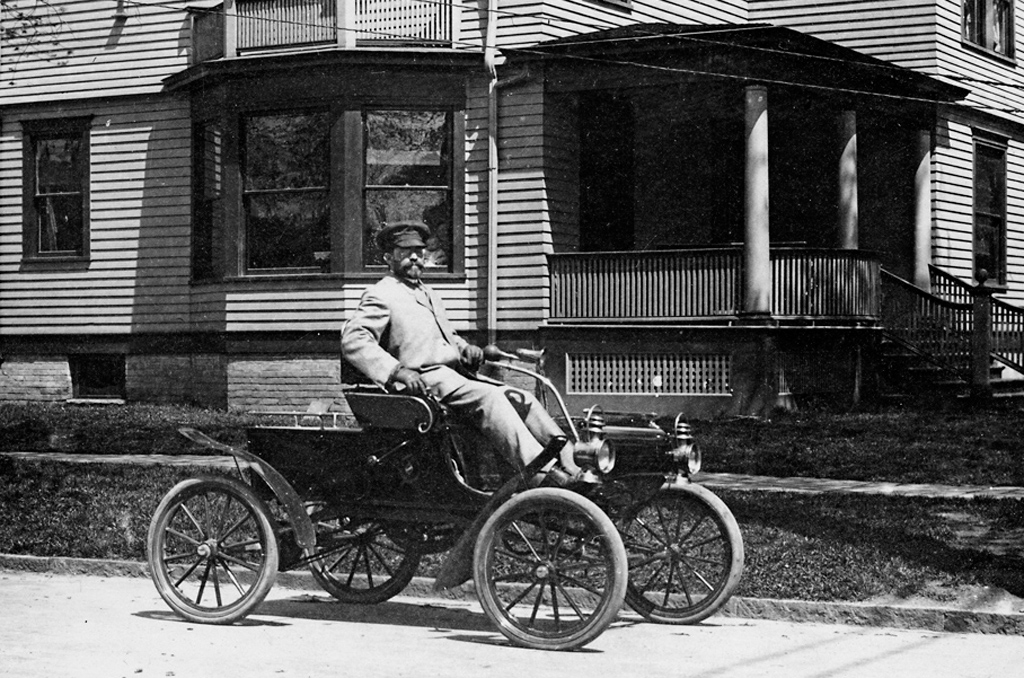
The Passing of the Horse
Ransom Eli Olds was born in Geneva, Ohio in 1864, the youngest of three sons of Pliny Fisk Olds. Pliny Olds owned and operated a small machine shop that built and repaired machinery. After the Civil War ended, he recognized the developing industrial revolution combined with increasing numbers of immigrant workers created the potential for significant growth in America’s manufacturing centers. Pliny Olds wanted to be part of it, so in 1870 he moved his family and business to Cleveland, then to a small farm in 1873, and finally settled in Lansing, Michigan in 1880. The moves paid off handsomely, and Ransom’s time spent on that small farm was significant in the development of the automobile.
Ransom Olds (nicknamed Ranny) was a highly intelligent boy who was fascinated by the many machines and devices that streamed through his father’s machine repair shop. He had an active, orderly mind that understood mechanical principles intuitively, and he augmented that gift by studying and practicing the manufacturing processes his father used to repair his customers’ machines. Not only that, but he had a strong entrepreneurial spirit and an inventive streak. All of this was a powerful combination for success, but perhaps the one thing that lead him to his life’s work as much as anything was while on the farm he discovered he hated horses!
After the family settled in Lansing, Pliny Olds set up shop as P.F. Olds and Son. The “Son” was actually Ransom’s older brother Wallace. Ranny started work there in 1880 at the age of 16. With his help the shop designed, manufactured, and sold a small gasoline-heated steam engine that became their primary product. Ranny soon bought out his brother and the business thrived.
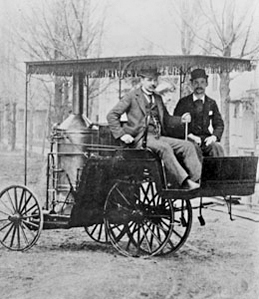
R.E. Olds testing his early steam car.
This growth gave Olds the resources to experiment with a “self-propelled carriage” to replace the horse as a means of transportation. In 1887 he built a primitive steam powered car, and by 1892 he developed and built a second steam car which was sold to a customer in Bombay, India. This was the first-ever car exported from Michigan and also from the United States to a foreign country!
The following year Olds had a revelation in Chicago. He attended the 1893 World’s Columbian Exposition and discovered “hit-or-miss” internal combustion engines fueled by gasoline. These simple new engines were designed to power all sorts of industrial machinery and agricultural equipment. Olds was quick to realize that extracting energy from gasoline with an internal combustion engine would be far more efficient than using gasoline to first heat water and then extract mechanical energy from the resulting steam. Convinced internal combustion was the future of making useful power, Olds transformed the family business into a factory for hit-or-miss engines and renamed it the Olds Gasoline Engine Works.
The final fundamental innovation fell into place when Olds mounted one of his hit-or-miss engines onto a modified horse-drawn carriage, creating his first real prototype automobile. It worked so well that Olds formed a second company, the Olds Motor Vehicle Company, to produce additional cars. Of his horseless carriage, Olds said “It never kicks or bites, nor tires on long runs. It doesn’t require care in the stable and only eats when it’s on the road, which is no more than at the rate of one cent per mile.” The year was 1896. Olds finally had the horse in the crosshairs.
The Birth of the Oldsmobile
Olds’ determination and success in building a workable automobile did not go unnoticed. One of the directors of his company, Samuel L. Smith, was so sure of the potential of Olds’ car that he invested heavily and became the majority stockholder of both the engine works and the motor vehicle company. He then combined them to form the Olds Motor Works.
Smith was President and Olds became Vice President and General Manager. A number of automobile prototypes were built to refine Olds’ ideas. Olds tried various ways to power the cars including gasoline and electricity, and some of these early cars were sold. However, Olds settled on the internal combustion engine for volume production, and in 1900 the first Curved Dash Oldsmobile was produced.
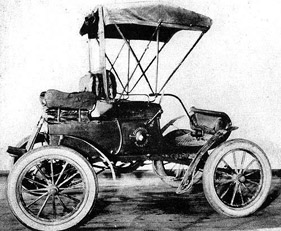
An early Curved Dash Oldsmobile.
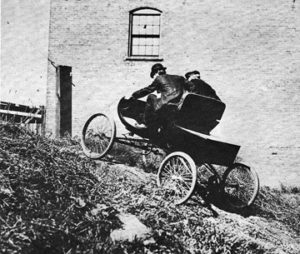
Product testing, circa 1900.
Smith and Olds built a large new factory in Detroit and started planning their product lines which contained several automobile models. Olds set up his suppliers, engineered his manufacturing processes, scheduled production, settled logistical arrangements, and was finally ready to start full scale manufacturing!
Then only a few weeks after production began in the new factory, it burned to the ground.
Once again Olds’ determination came into play. The fire forced him to quickly choose just one car to put into production – the Curved Dash Oldsmobile. He improvised production for a time by building the cars in a separate foundry building that had survived the fire. He had other manufacturers build engines, transmissions, and other parts to his design. These suppliers included the Dodge brothers, Henry Leland, and Benjamin Briscoe. Despite all of the setbacks, Olds was still able to build 425 Curved Dash Oldsmobiles in 1901.
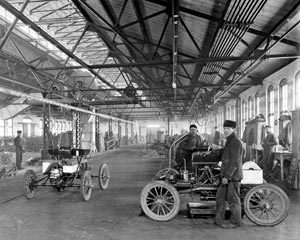
The Olds Motor Works factory.
A fortunate outcome of the fire was that the Lansing Business Man’s Club decided they wanted Olds to return and build his cars in Lansing, not Detroit, and made arrangements for a factory site at the local fairgrounds. Construction on the new factory began at once and production of the Curved Dash Oldsmobile began in Lansing to supplement the Detroit factory’s production.
Initially Olds produced 20 cars per day (which was a big number at that time) but it was not enough to meet demand. Olds hit upon progressive assembly as a way to increase production. By adding components to cars at sequential workstations in an assembly line, many cars could be built at the same time and thereby dramatically increase production. It was a true manufacturing breakthrough! Henry Ford had only built very small numbers of cars by this time, and later exploited the assembly line concept to its maximum potential. To make his assembly line practical, Olds also insisted that his cars be made of interchangeable parts. The goal was to make every part fit on every car every time.
The assembly line concept allowed production to increase at an astonishing rate. He had the cars to sell, but now Olds needed to create additional demand. He was innovative in marketing his products as well. To boost sales, Olds became one of the first automobile manufacturers to advertise nationally by placing an ad in The Hub in 1899. He advertised in a number of publications including The Motor, Motor Age, Horseless Age, and The Saturday Evening Post.
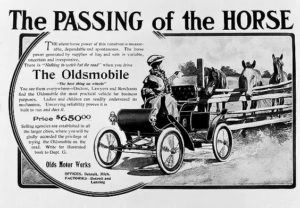
An early advertisement declaring the horse obsolete.
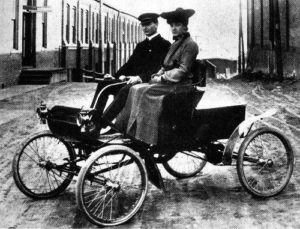
By advertising, the Oldsmobile gained widespread acceptance.
After starting his advertising campaign, Oldsmobile sales quintupled to 2,500 cars in 1902. By 1904 Olds Motor Works was producing 5,000 cars per year! The Curved Dash had quickly become the best-selling car in the country.
Olds had realized his goal of providing an alternative to the horse that was reliable, affordable, and easily operated by common people and this resulted in automobile sales volumes never before seen. However, a major problem developed. Samuel Smith had brought his son Frederick into the business, and they wanted to produce only exclusive luxury cars for wealthy customers. After many battles between Olds and the Smiths over company direction, in 1904 Olds left the company he helped create.
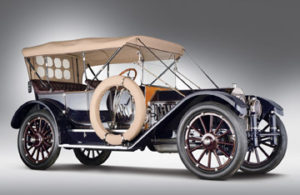
Building luxurious cars like this Limited nearly ruined the company!
Olds may have had some small satisfaction that very soon after, the Smiths nearly bankrupted the company with their ideas. It was only saved in 1908 when William C. Durant bought and added it to the organization he was building – General Motors. Another consolation was that Olds had sold the stock he held in the company and found himself quite wealthy. And ready for his next successful business venture.
Epilogue
Ransom Eli Olds is considered by many to be the father of the automobile industry. He experimented with a variety of motive power for his cars, settling on the internal combustion engine. He invented the assembly line for producing automobiles and became the highest volume manufacturer at the dawn of the automobile age. He used interchangeable parts to build his cars. He developed a supplier network much like the ones auto makers have now, and he had a huge role in making Detroit the center of American automobile manufacturing.
His next venture after leaving the Olds Motor Works was to form REO Motor Car Company, which by 1907 was one of the top 4 American manufacturers with a 25% market share.
Olds had many interests other than building automobiles. For example, he manufactured an improved gasoline powered lawn mower, was an early land developer in Florida, and engaged in philanthropic pursuits supporting education. He was also civic minded and active in local and state affairs.
After he passed away in 1950, The Detroit Free Press obituary included “Death came to the production genius in his rambling Victorian mansion in downtown Lansing. He passed away amid the noisy, rumbling traffic he helped develop. Ransom Eli Olds was a pioneer within a select group of inventive geniuses whose mechanical skill, resourcefulness and promotional daring ushered in the motor age. Mr. Olds gave the world its first practicable low-priced automobile, the industry its first volume production and Detroit its first automobile factory.”
Visit the Museum!
The R. E. Olds Transportation Museum is dedicated to Lansing, Michigan’s most well-known citizen, R. E. Olds. Displays illustrate the history of the Oldsmobile and Mr. Olds’ other car make, the REO. The Olds family’s history is depicted, and the collection includes the first R. E. Olds-built motor vehicles, including a steam powered three wheeler and an 1899 electric car. Many other forms of transportation are represented as well from the dawn of the age of the automobile through World War II and into the present!
The museum holds many surprises that will delight visitors of all ages. It is open Tuesday-Saturday 10am – 5pm, and Sundays in summer 12pm to 5pm. Group guided tours are available, and you may become a member of the museum! It is located at 240 Museum Drive, Lansing, Michigan 48933
Call for more information at (517) 372-0529, or visit the museum website at http://www.reoldsmuseum.org/
by William Hoffer








I love your post,
Thanks for sharing, great work keep it up.